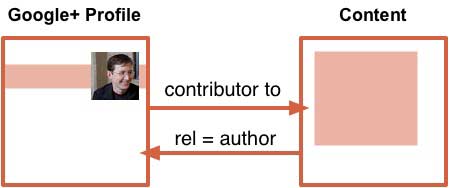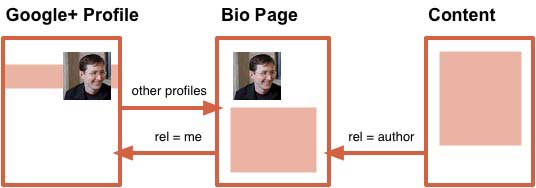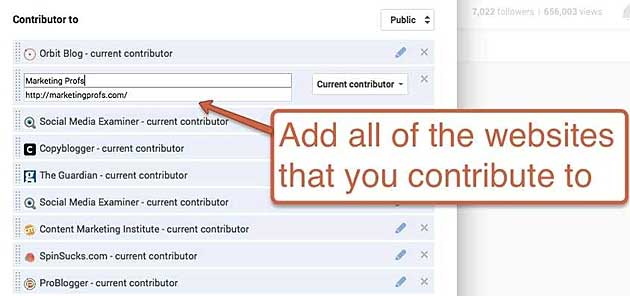It's a search engine. It's a social network. Google is a lot of things, and its parts are interconnected.
First, some background
The same month that the Google+ social network was launched, Google announced a new way to link writers to content they create: Google Authorship. Along with personalized search results, Authorship became a second direct connection between the social network and Google search results.
Until June 24, 2014, on its search results pages, Google showed author pictures (taken from the Google+ profile page), the name, and the number of G+ circles the author had been added to.
It looked like this:

Researchers found that when an author's picture appeared next to a search result, the clickthrough rate for the search result went up. The "rich snippet" for Authorship was increasing traffic. One study showed a lift of 35%. Authorship was suddenly a way to get more traffic from the same rankings.
On August 28, Google removed the author's byline as well, so that the same search result looked like this:

No picture? No byline? Then what's the point?
Obviously, the interest in Authorship dropped. To most bloggers, it was all about seeing their face and name.
But there are three good reasons to still use Authorship. They all relate to visibility.
- Author pictures are still there in personalized results. Anyone who is logged in and hasn't turned off personalized search results will see your picture and byline, as long they've added you to a circle.
- Drive traffic to your Google+ profile. Creating another path from Google search to a social profile is a good thing.
- Author authority may eventually affect rankings. Google patented the ability to use author information as a ranking factor way back in 2005 in the now-famous "Author Rank" patent. It seems committed to using author information to determine quality. Statements from Google indicate that connecting authors to content is still its goal.
Authorship is a digital signature. If you're interested in personal branding or thought leadership, then you'll want to keep signing your name. It's good for visibility, which is good for networking.
Google Authorship is simply best-practice for any writer. And it's not difficult to set up.
Here's how to add your digital signature
The best way to digitally sign your work is with the "two link method," which involves linking from the authored page to your Google+ profile and vice versa.

Note: There is also a "three link method," but it is used mostly by large multi-author blogs. It involves linking from an authored page to an author bio page on the same site, and then from that bio page to a Google+ profile.

There are two steps in the two-link method.
Step 1: Link from your Google+ profile to your content
On your G+ "About" page, in the "Links" section, in the "Contributor to" area, add the URL for the site where your content has been published. There's no need to link to the specific article. Just add the link for the homepage of the site. Indicate that you are a "current contributor" to the site.
If you contribute to more that one website, add each site to this list. (Authorship is great for guest bloggers!)

Step 2: Link from the article to your Google+ profile in your author bio
This part is a tiny bit trickier. You're going to link from your author bio to Google+, but you need to add a tiny bit of code to it.
Your bio likely already has a link or two in it. One of those links is going to be to your Google+ profile.

In the code for that link, you're going to add a special tag: rel="author" We're going to add it in two places. So rather than this...
<a href="https://plus.google.com/113272929328812128697>Google+</a>
The code for the link will look like this...
<a rel="author" href="Google+https://plus.google.com/113272929328812128697?rel="author">Google+</a>
That's it! It didn't hurt a bit, did it?
Tip for WordPress users: There are plugins, such as Author Box Reloaded, that will add the markup for you. These tools also create nice author boxes that include your picture and icons for all of your social networks.
Tip for guest bloggers: If you contribute content to other blogs, I recommend sending over the HTML for your entire bio when you submit your final draft. This is a way to make sure the tags go into the right place. It also makes it simple for the blog editor to add. Here's an example of what that might look like:
Andy Crestodina is a co-founder of <a href="https://www.orbitmedia.com">Orbit Media</a>, a Web design company in Chicago. Connect with Andy on <a rel="author" href="https://plus.google.com/113272929328812128697?rel=author" target="_blank">Google+</a> and <a href="https://www.twitter.com/crestodina" target="_blank">Twitter</a>.
Check results
You'll have to wait a few days to see if your name shows in personalized Google search results. To check, make sure you're logged into Google+ and you search for the entire title of the article or a long sentence from the body text. When you see it in the search results, look for your name/link in the snippet.
If it didn't work, try the following:
- Enter the address of the authored page into Google's Structured Data Testing Tool. It should say "authorship is working for this webpage."
- In your "Contributor to" links, link directly to a specific post, rather that the website homepage.
- Check the HTML for the authored page and make sure there aren't two links with rel="author" tags going to different locations. You can add only one digital signature!
The future of search is social
Google Authorship doesn't make you rank higher. It doesn't show your picture. But if you wrote it, why not sign your name to it?
The Web is always becoming more personalized and more connected, and rel="author" is one of hundreds of little tags that are changing how the Web works. If you're a marketer, creating a direct connection between you and your content is definitely a good idea.




